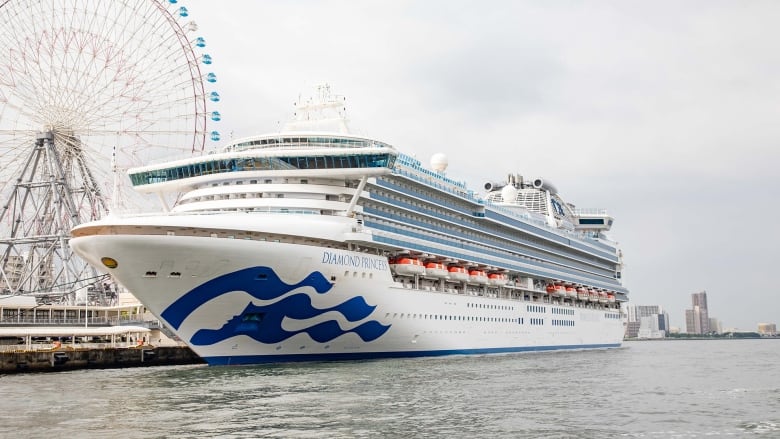Cruise lines are looking to innovate and stay afloat in a post-pandemic world
Despite some alarming headlines, cruise-loving passengers are keen to return to sea

Roughly 30 million people around the world took a cruise in 2019; another one million worked in the industry. Those numbers combined come close to the entire population of Canada — sailing across oceans on luxurious, entertainment-filled ships.
Cruise vacations have exploded in popularity since the 1970s into a multibillion-dollar global business. But as for so many other industries, the COVID-19 pandemic has changed everything. The Covid Cruise, a documentary from The Nature of Things explores one dramatic outbreak as it unfolded on a cruise ship — the Diamond Princess — in February 2020.
"[Cruise ships] were really one of the first industries to be hit in any sizable way," says Ross Klein, a professor at Memorial University of Newfoundland and industry expert on cruises. "In some ways, after Wuhan, they were the leading news item that brought COVID-19 into people's realities."
How will cruises evolve in a pandemic-ravaged world? And will they be recognizable to the people that love them?
New safety and hygiene protocols at every step
In September, Cruise Lines International Association (CLIA) released its "Core Elements of Health Protocols" as part of its "highly controlled" return to operations.
Included in the mandatory updates:
- testing of all passengers and crew;
- wearing masks when physical distancing cannot be maintained;
- distancing in terminals, ships and during shore excursions;
- improved air management and ventilation;
- medical upgrades and response plans,
- including cabin capacity for isolation;
- arrangements with private providers for quarantine on shore;
- and carefully managed shore excursions.
Prior to these new protocols being established, some companies had already taken action: Norwegian Cruise Line installed new air filtration systems with medical-grade filters among its measures; and MSC Cruises launched a ship in August with strict screening and monitoring in place.
Cruise ships may work toward creating an infection-free "bubble," but Klein says it's unclear how ports could maintain that bubble during passengers' shore excursions.
"They probably will cut back on the number of ports, but you can't get rid of them," he says. "And every time you go to a port, that introduces all kinds of risks … You've got port workers dealing with the workers on the cruise ship; you've got shore excursions, people on shore providing experiences to people from onboard. You may have food and other products being offloaded, on-loaded."
"All it takes is one," Klein says of the potential for a new outbreak.
Consolidation among cruise lines and new business models
The financial hit will be significant, and Klein expects a reshuffling of companies and assets.
"I could see some further redrawing of the industry and that would mean consolidation — some of the corporations perhaps losing cruise lines," he says. "They're already letting go of cruise ships, but letting go of cruise lines and combining cruise lines."
Klein wrote a chapter on the cruise industry for the 2018 book Tourists and Tourism, where he explores how the business model has evolved in recent decades to move away from ticket revenue and toward onboard profits.
In other words, low ticket prices lure passengers into a spending environment.
"The business model is based on generating huge amounts of onboard revenue, which is based on shore excursions, people spending in the bars, in the casino — all those contact environments," Klein says.
With a dangerous pandemic lurking, however, many of those revenue opportunities will be limited or tightly controlled. It's also likely that ships will let fewer passengers onboard to maintain social distancing. Klein says the business model will have to evolve — how, exactly, remains to be seen.
Reimagining the cruise experience
"I think the biggest challenge is going to be how they're going to be able to deliver a product that's something close to what passengers want," Klein says, citing the popular draws of lavish shows, shore excursions and meeting other travellers.
The things that people go on a cruise for are the very things that are high-risk.
"Do people want to go on a cruise where they don't get to be part of those social groupings?" he asks. "The things that people go on a cruise for are the very things that are high-risk."
Yet one of the most fascinating aspects of a cruise industry grappling with a global pandemic is passenger enthusiasm.
As The Covid Cruise reveals, passengers aboard the Diamond Princess received a voucher for a free cruise: "And despite what you would think, every passenger I talked to said that they were going to take them up on it in the future," says magazine journalist Lauren Smiley in the documentary.
Klein says he expects the billion-dollar industry to bounce back with "innovative itineraries," in addition to enhanced health protocols, to keep the passengers happy and healthy — and profits coming in.
"They're masters at that kind of stuff," he says. "So I'm sure they're going to land on their feet. It's just how long will it take, and how many missteps will there be?"
Watch The Covid Cruise on The Nature of Things.

